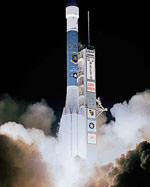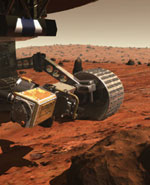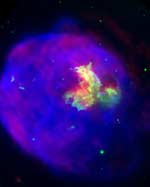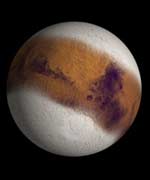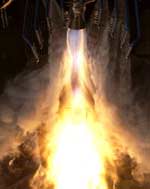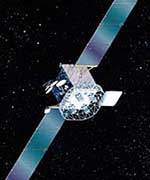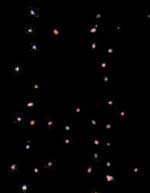
Image credit: ESO
Although the Universe is currently a beige colour overall, it used to be more blue, according to astronomers with the European Southern Observatory. This was caused by the predominantly hot, young blue stars in the most distant galaxies – astronomers are seeing them when the Universe was only 2.5 billion years old. The astronomers worked out the distance and colour to 300 galaxies which were contained within the Hubble Deep Sky survey, which took a deep look at a region of sky in the southern constellation of Tuscanae.
An international team of astronomers [1] has determined the colour of the Universe when it was very young. While the Universe is now kind of beige, it was much bluer in the distant past, at a time when it was only 2,500 million years old.
This is the outcome of an extensive and thorough analysis of more than 300 galaxies seen within a small southern sky area, the so-called Hubble Deep Field South. The main goal of this advanced study was to understand how the stellar content of the Universe was assembled and has changed over time.
Dutch astronomer Marijn Franx, a team member from the Leiden Observatory (The Netherlands), explains: “The blue colour of the early Universe is caused by the predominantly blue light from young stars in the galaxies. The redder colour of the Universe today is caused by the relatively larger number of older, redder stars.”
The team leader, Gregory Rudnick from the Max-Planck Institut f?r Astrophysics (Garching, Germany) adds: “Since the total amount of light in the Universe in the past was about the same as today and a young blue star emits much more light than an old red star, there must have been significantly fewer stars in the young Universe than there is now. Our new findings imply that the majority of stars in the Universe were formed comparatively late, not so long before our Sun was born, at a moment when the Universe was around 7,000 million years old.”
These new results are based on unique data collected during more than 100 hours of observations with the ISAAC multi-mode instrument at ESO’s Very Large Telescope (VLT), as part of a major research project, the Faint InfraRed Extragalactic Survey (FIRES). The distances to the galaxies were estimated from their brightness in different optical near-infrared wavelength bands.
Observing the early Universe
It is now well known that the Sun was formed some 4.5 billion years ago. But when did most of the other stars in our home Galaxy form? And what about stars in other galaxies? These are some of the key questions in present-day astronomy, but they can only be answered by means of observations with the world’s largest telescopes.
One way to address these issues is to observe the very young Universe directly – by looking back in time. For this, astronomers take advantage of the fact that light emitted by very distant galaxies travels a long time before reaching us. Thus, when astronomers look at such remote objects, they see them as they appeared long ago.
Those remote galaxies are extremely faint, however, and these observations are therefore technically difficult. Another complication is that, due to the expansion of the Universe, light from those galaxies is shifted towards longer wavelengths [2], out of the optical wavelength range and into the infrared region.
In order to study those early galaxies in some detail, astronomers must therefore use the largest ground-based telescopes, collecting their faint light during very long exposures. In addition they must use infrared-sensitive detectors.
Telescopes as giant eyes
The “Hubble Deep Field South (HDF-S)” is a very small portion of the sky in the southern constellation Tucanae (“the Toucan”). It was selected for very detailed studies with the Hubble Space Telescope (HST) and other powerful telescopes. Optical images of this field obtained by the HST represent a total exposure time of 140 hours. Many ground-based telescopes have also obtained images and spectra of objects in this sky area, in particular the ESO telescopes in Chile.
A sky area of 2.5 x 2.5 arcmin2 in the direction of HDF-S was observed in the context of a thorough study (the Faint InfraRed Extragalactic Survey; FIRES, see ESO PR 23/02). It is slightly larger than the field covered by the WFPC2 camera on the HST, but still 100 times smaller than the area subtended by the full moon.
Whenever this field was visible from the ESO Paranal Observatory and the atmospheric conditions were optimal, ESO astronomers pointed the 8.2-m VLT ANTU telescope in this direction, taking near-infrared images with the ISAAC multi-mode instrument. Altogether, the field was observed for more than 100 hours and the resulting images (see ESO PR 23/02), are the deepest ground-based views in the near-infrared Js- and H-bands. The Ks-band image is the deepest ever obtained of any sky field in this spectral band, whether from the ground or from space.
These unique data provide an exceptional view and have now allowed unprecedented studies of the galaxy population in the young Universe. Indeed, because of the exceptional seeing conditions at Paranal, the data obtained with the VLT have an excellent image sharpness (a “seeing” of 0.48 arcsec) and can be combined with the HST optical data with almost no loss of quality.
A bluer colour
The astronomers were able to detect unambiguously about 300 galaxies on these images. For each of them, they measured the distance by determining the redshift [2]. This was done by means of a newly improved method that is based on the comparison of the brightness of each object in all the individual spectral bands with that of a set of nearby galaxies.
In this way, galaxies were found in the field with redshifts as high as z = 3.2, corresponding to distances around 11,500 million light-years. In other words, the astronomers were seeing the light of these very remote galaxies as they were when the Universe was only about 2.2 billion year old.
The astronomers next determined the amount of light emitted by each galaxy in such a way that the effects of the redshift were “removed”. That is, they measured the amount of light at different wavelengths (colours) as it would have been recorded by an observer near that galaxy. This, of course, only refers to the light from stars that are not heavily obscured by dust.
Summing up the light emitted at different wavelengths by all galaxies at a given cosmic epoch, the astronomers could then also determine the average colour of the Universe (the “cosmic colour”) at that epoch. Moreover, they were able to measure how that colour has changed, as the Universe became older.
They conclude that the cosmic colour is getting redder with time. In particular, it was much bluer in the past; now, at the age of nearly 14,000 million years, the Universe has a kind of beige colour.
When did stars form ?
The change of the cosmic colour with time may be interesting in itself, but it is also an essential tool for determining how rapidly stars were assembled in the Universe.
Indeed, while the star-formation in individual galaxies may have complicated histories, sometimes accelerating into true “star-bursts”, the new observations – now based on many galaxies – show that the “average history” of star-formation in the Universe is much simpler. This is evident by the observed, smooth change of the cosmic colour as the Universe became older.
Using the cosmic colour the astronomers were also able to determine how the mean age of relatively unobscured stars in the Universe changed with time. Since the Universe was much bluer in the past than it is now, they concluded that the Universe is not producing as many blue (high mass, short-lived) stars now as it was earlier, while at the same time the red (low mass, long-lived) stars from earlier generations of star formation are still present. Blue, massive stars die more quickly than red, low-mass stars, and therefore as the age of a group of stars increases, the blue short-lived stars die and the average colour of the group becomes redder. So did the Universe as a whole.
This behaviour bears some resemblance with the ageing trend in modern Western countries where less babies are born than in the past and people live longer than in the past, with the total effect that the mean age of the population is rising.
The astronomers determined how many stars had already formed when the Universe was only about 3,000 million years old. Young stars (of blue colour) emit more light than older (redder) stars. However, since there was just about as much light in the young Universe as there is today – although the galaxies are now much redder – this implies that there were fewer stars in the early Universe than today. The present study inidcates that there were ten times fewer stars at that early time than there is now.
Finally, the astronomers found that roughly half of the stars in the observed galaxies have been formed after the time when the Universe was about half as old (7,000 million years after the Big Bang) as it is today (14,000 million years).
Although this result was derived from a study of a very small sky field, and therefore may not be completely representative of the Universe as a whole, the present result has been shown to hold in other sky fields.
Original Source: ESO News Release


